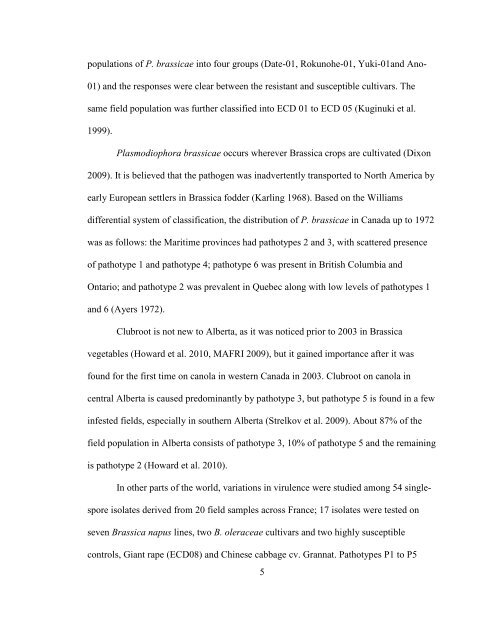Hema Kasinathan Thesis May 1 2012.pdf - Atrium - University of ...
Hema Kasinathan Thesis May 1 2012.pdf - Atrium - University of ...
Hema Kasinathan Thesis May 1 2012.pdf - Atrium - University of ...
You also want an ePaper? Increase the reach of your titles
YUMPU automatically turns print PDFs into web optimized ePapers that Google loves.
populations <strong>of</strong> P. brassicae into four groups (Date-01, Rokunohe-01, Yuki-01and Ano-01) and the responses were clear between the resistant and susceptible cultivars. Thesame field population was further classified into ECD 01 to ECD 05 (Kuginuki et al.1999).Plasmodiophora brassicae occurs wherever Brassica crops are cultivated (Dixon2009). It is believed that the pathogen was inadvertently transported to North America byearly European settlers in Brassica fodder (Karling 1968). Based on the Williamsdifferential system <strong>of</strong> classification, the distribution <strong>of</strong> P. brassicae in Canada up to 1972was as follows: the Maritime provinces had pathotypes 2 and 3, with scattered presence<strong>of</strong> pathotype 1 and pathotype 4; pathotype 6 was present in British Columbia andOntario; and pathotype 2 was prevalent in Quebec along with low levels <strong>of</strong> pathotypes 1and 6 (Ayers 1972).Clubroot is not new to Alberta, as it was noticed prior to 2003 in Brassicavegetables (Howard et al. 2010, MAFRI 2009), but it gained importance after it wasfound for the first time on canola in western Canada in 2003. Clubroot on canola incentral Alberta is caused predominantly by pathotype 3, but pathotype 5 is found in a fewinfested fields, especially in southern Alberta (Strelkov et al. 2009). About 87% <strong>of</strong> thefield population in Alberta consists <strong>of</strong> pathotype 3, 10% <strong>of</strong> pathotype 5 and the remainingis pathotype 2 (Howard et al. 2010).In other parts <strong>of</strong> the world, variations in virulence were studied among 54 singlesporeisolates derived from 20 field samples across France; 17 isolates were tested onseven Brassica napus lines, two B. oleraceae cultivars and two highly susceptiblecontrols, Giant rape (ECD08) and Chinese cabbage cv. Grannat. Pathotypes P1 to P55
















